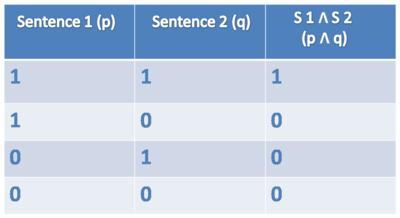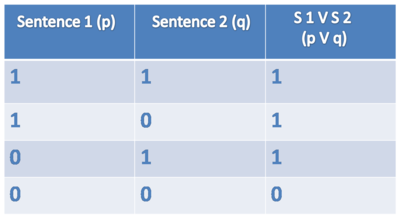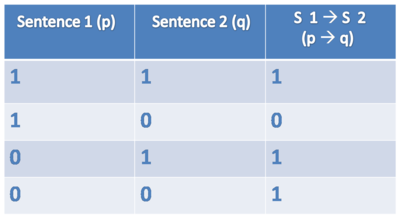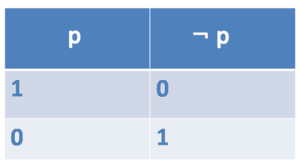Wiki-ch2: Difference between revisions
No edit summary |
|||
| Line 92: | Line 92: | ||
<embedvideo service="youtube" dimensions="400">http://www.youtube.com/watch?v=ZWdltj5Mqdc</embedvideo> | <embedvideo service="youtube" dimensions="400">http://www.youtube.com/watch?v=ZWdltj5Mqdc</embedvideo> | ||
== Formulae with connectives == | == Formulae with connectives == | ||
| Line 113: | Line 111: | ||
<embedvideo service="youtube" dimensions="400">http://youtu.be/C1rjU104R54</embedvideo> | <embedvideo service="youtube" dimensions="400">http://youtu.be/C1rjU104R54</embedvideo> | ||
= Logical determiners/quantifiers = | = Logical determiners/quantifiers = | ||
Revision as of 15:46, 13 October 2019
Models
The following material is an adapted form of material created by student participants of the project e-Learning Resources for Semantics (e-LRS). Involved participants: Lisa, Marthe, Elisabeth, Isabelle.
Watch a short podcast what first-order models look like.
Based on this podcast, we can define a model as follows:
- Universe: U = {LittleRedRidingHood, Grandmother, Wolf}
- Properties:
red-hood = { < x> | x wears a read hood } = { <LittleRedRidingHood> }
female = { <x> | x is female } = { <LittleRedRidingHood>, <Grandmother> }
big-mouth = { <x> | x has a big mouth } = { <Wolf> }
live-in-forest = { < x> | x lives in the forest } = { <Grandmother>, <Wolf>} - Relations:
grand-child-of = { <x,y> | x is y 's grandchild } = { <LittleRedRidingHood,Grandmother > }
afternoon-snack-of = { <x,y> | x is y 's afternoon snack } = { <LittleRedRidingHood,Wolf > }
Atomic formulae
The following video presents the step-by-step computation of the truth value of two atomic formulae. The example uses a model based on Shakespeare's play Macbeth. The two formulae are:
- kill(macbeth,duncan)
- kill(lady-macbeth,macbet)
Connectives
Truth tables
The following material is an adapted form of material created by student participants of the project e-Learning Resources for Semantics (e-LRS). Involved participants: Lisa, Marthe, Elisabeth, Isabelle.
Truth tables for connectives
AND (∧)
Symbol: ∧
Sentence: Harry is a student and Snape is a teacher.
Formulae: student(harry) ∧ teacher(snape)
A conjunction p ∧ q it true if and only if p is true and q is true.
Truthtable AND
OR (∨)
Symbol: ∨
Sentence: Harry is a student or Snape is a teacher.
Formulae: student(harry) ∨ teacher(snape)
A disjunction p ∨ q is true if and only if p is true or q is true (or both).
Truthtable OR
IF/THEN (⊃, →)
Symbol: ⊃, → (Note: We use the symbol ⊃ in the textbook as it is more common in the logical literature.)
Sentence: If Harry is a student then Snape is a teacher.
Formula: student(harry) ⊃ teacher(snape)
An implication p ⊃ q is true if and only if p is false or q is true (or both).
In other words: An implication p ⊃ q is true if and only if whenever p is true, q is true as well.
Truthtable IF/THEN
NOT (¬)
Symbol: ¬
Sentence: Harry is not a student.
Formula: ¬student(harry)
A negated formula ¬p is true if and only if p is false.
Example: Only if student(harry) is false, ¬student(harry) is true.
Truthtable NOT
Truth tables for complex formulae
Truth tables are also useful to compute the truth value of complex formulae. This is shown in the following podcast, created by Lisa Günthner.
Formulae with connectives
The following video presents the step-by-step computation of the truth value of two formulae with connectives. The example uses a model based on Shakespeare's play Macbeth. The two formulae are:
- ¬ king(lady-macbeth)
- king(duncan) ∨ king(lady-macbeth)
The next video shows how the truth value of a more complex formula can be computed. The example contains two connectives:
kill(malcom,lady-macbeth) ∨ ¬thane(macbeth)
The video shows two different methods: top down and bottom up.
Logical determiners/quantifiers
Video introducing determiners into our logical language. (The video is based on the scenario of Romeo and Juliett.)
Links
Predicate logic in the Virtual Linguistics Campus
There are short lectures by Jürgen Hanke (Virtual Linguistics Campus) related to the topics of Chapter 2:
- Predicates and their arguments
- Logical connectives
- Quantifiers ("∀" and "∃")
- Note: The video mentions the terms "restrictor" and "scope" of a quantifier but uses the conventional first-order representation of quantifiers. This means that the restrictor and the scope are linked by an implication ("⊃") in the case of a universal quantifier and by a conjunction ("∧") in the case of the existential quantifier.
So, where we write: ∀ x (φ : ψ), the traditional notation is: ∀ x (φ ⊃ ψ),
and where we write ∃ x (φ : ψ), the traditional notation is ∃ x (φ ∧ ψ) - Note: In the video, the symbol "¬" is called "the negative quantifier". This is to be seen as short hand for "¬∃"
- Note: The video mentions the terms "restrictor" and "scope" of a quantifier but uses the conventional first-order representation of quantifiers. This means that the restrictor and the scope are linked by an implication ("⊃") in the case of a universal quantifier and by a conjunction ("∧") in the case of the existential quantifier.
Pine's Essential Logic: Basic Reasoning Skills for the 21st Century
Ronald C. Pine is profesor of philosophy at the Honolulu Community College. He has put online a number of courses and a version of his book on logic, entitled Essential Logic: Basic Reasoning Skills for the 21st Century:
Pine, Ronald C.: Essential Logic: Basic Reasoning Skills for the 21st Century. Harcourt, 1996; Oxford University Press, 2001; online edition, 2011.
URL: http://home.honolulu.hawaii.edu/~pine/EL/Essential-Logic.html
The book's content goes far beyond what we cover in our textbook.
Back to
- the material for chapter 2
- the overview over all chapters



